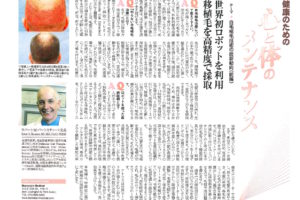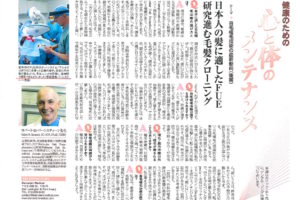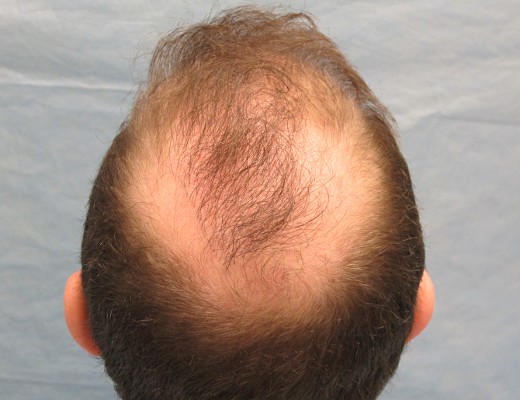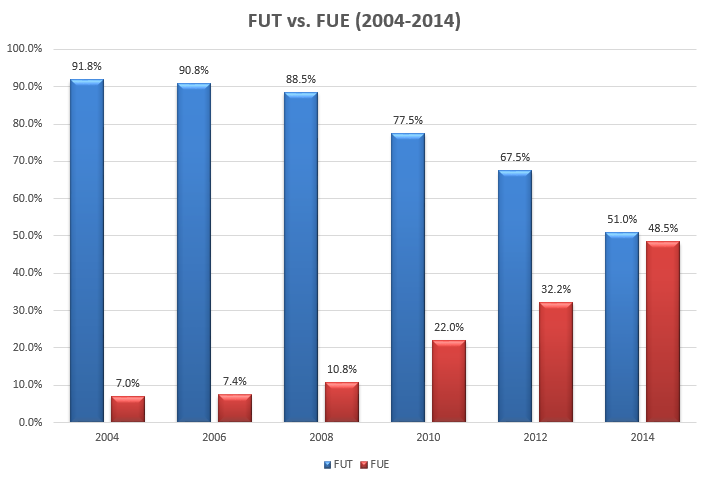 Dr. Bernstein Interviewed in NY Japion Pt 1
Dr. Bernstein Interviewed in NY Japion Pt 1
 Dr. Bernstein Interviewed in NY Japion Pt 2
Dr. Bernstein Interviewed in NY Japion Pt 2
Dr. Bernstein was featured in a wide-ranging interview published in the New York City-based, Japanese language magazine NY Japion. Among the topics discussed were the differences between FUT and FUE hair transplants, updates on robotic hair transplant technology, the type of procedure most beneficial for Asian patients, criteria that determine candidacy for a hair transplant, and more. Below are some selections from the interview.
On FUT vs FUE:
FUT is more economical than FUE and also more beneficial for patients who wear their hair longer. However, if your plan is to have the option of wearing your hair short, FUT is not for you. That is because with FUT you will have a fine linear scar after the donor area (the area where strip is removed) is sutured, and this may be seen visible with short hair.
On robotic FUE hair transplantation and the ARTAS Robot:
In the case of ARTAS, an advanced camera system and a computer analyzes images of the scalp and calculates angle and direction of individual hairs, hair density and number of hairs in each follicular unit instantly. Then, based on that calculation, the computer controls the punch so that it goes into the skin at the right angle and depth so that it will not damage hair root and/or surrounding tissues. So far, 135 systems of ARTAS have been installed worldwide. About half of them are in the United States and 11 are in Japan. Currently, 5% of hair transplant treatments are performed with ARTAS worldwide.
On which type of hair transplant is more beneficial for Asian people:
FUE is especially good for Asians, including Japanese. With Asians, scars tend to widen. In addition, Asians usually have coarse hair that grows more perpendicular to the skin than in Caucasian scalps, so a linear scar in the donor area (using FUT) may be more visible — especially if the hair is worn short.
On who is a good candidate for a hair transplant:
Some people are candidates for hair transplantation, but some are not. Since a hair transplant uses a patients’ own hairs and relocates them from the permanent zone in the back of the scalp to areas that are thinning or bald, it is necessary that patients have good and sufficient hairs for that.
On the appropriate age to consider hair transplant surgery:
Hair transplants are not for young people since their future balding is so difficult to predict. Young patients should not consider hair transplant as a technique to prevent hair loss. Prevention is best accomplished by medications. The most effective are Propecia (finasteride) and Rogaine (minoxidil). These medications do have some side effects that need to be considered before starting. In general, hair transplant surgery should not be performed for people under 25. There are exceptions, but I prefer for patients to wait until 30 and over.
Dr. Bernstein’s wife Shizuka Bernstein was born in Tokyo, and the two travel to Japan frequently. Shizuka is a master-aesthetician and owns an award-winning day spa by Rockefeller Center in New York City called Shizuka NY. Shizuka developed her own line of skin-care products based on powerful natural anti-aging ingredients and pure Mt. Fuji spring water. She has been seen on CNN, CNBC, Fox News, The Today Show, The Early Show, CBS’s The Doctors, and E!’s red carpet special leading up to the Primetime Emmy Awards.
Posted by Robert M. Bernstein M.D. 






 “Dermatologic Clinics” is a quarterly review with comprehensive, state-of-the-art information by experts in the field of dermatology. The industries most highly knowledgeable medical professionals provide current, practical information on the diagnosis and treatment of conditions affecting the skin. Each issue of Dermatologic Clinics focuses on a single topic. The July 2005 issue, entitled “Advanced Cosmetic Surgery”, published an article authored by Robert M. Bernstein M.D, and co-authored by William R. Rassman M.D. entitled “
“Dermatologic Clinics” is a quarterly review with comprehensive, state-of-the-art information by experts in the field of dermatology. The industries most highly knowledgeable medical professionals provide current, practical information on the diagnosis and treatment of conditions affecting the skin. Each issue of Dermatologic Clinics focuses on a single topic. The July 2005 issue, entitled “Advanced Cosmetic Surgery”, published an article authored by Robert M. Bernstein M.D, and co-authored by William R. Rassman M.D. entitled “



